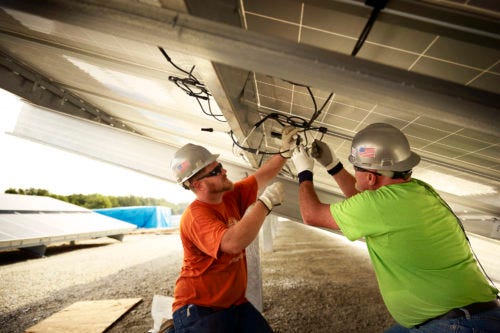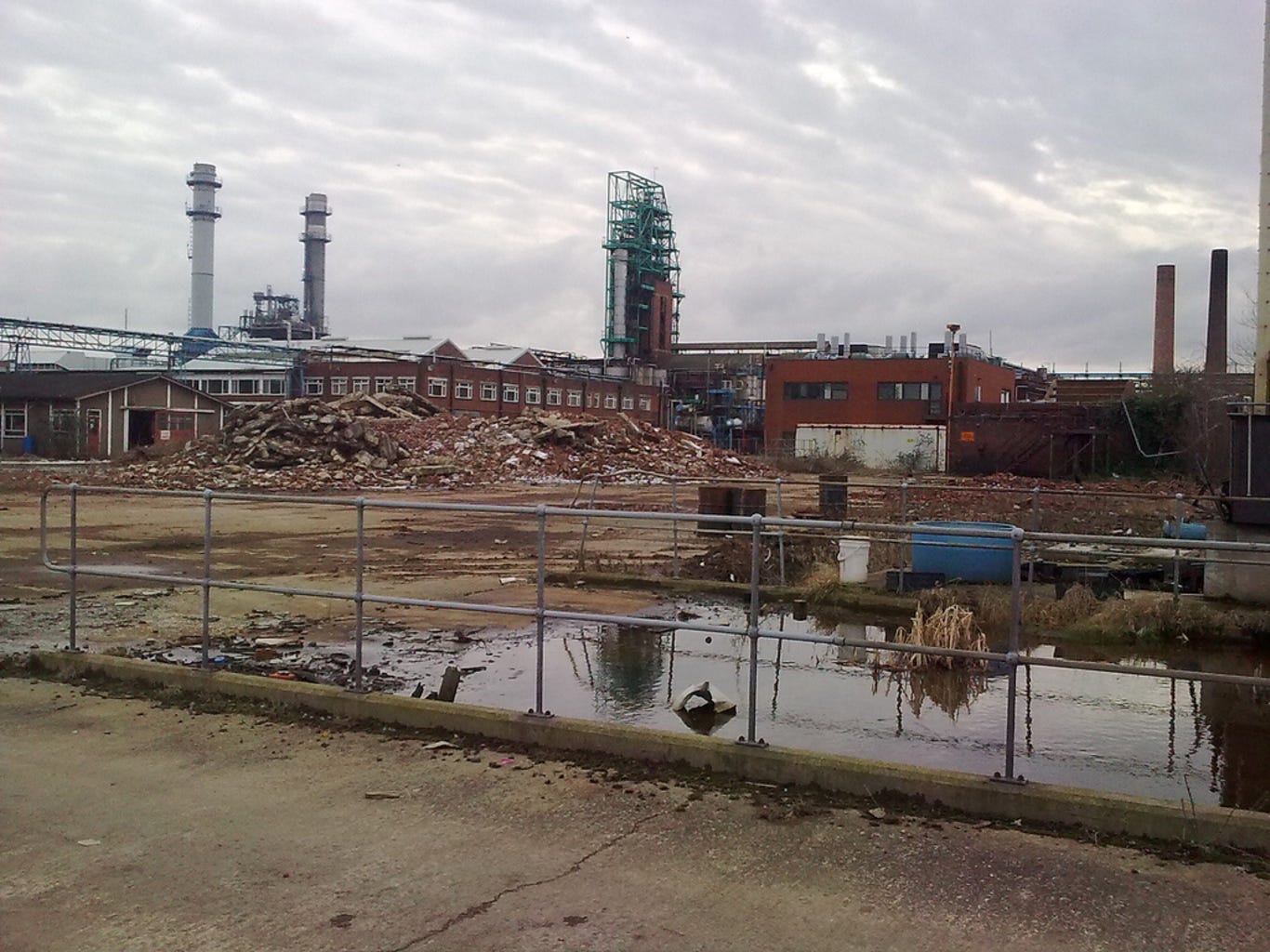#23: What Is The Climate Job We Need Most, That Not Enough People Do?
Suppose an 18-year old comes up to you, committed to decarbonisation, and asks: 'what career should I follow for the highest net impact?' What should you say?
PRESSED FOR TIME?
If you’re under 35, there’s a good chance you can make a career pivot to one of the many in-demand climate change occupations the world needs between now and 2050. If you’ve a child under 18, they’ll be entering a working world unrecognisable from the one we see today. Three jobs examined in this issue would’ve been barely imaginable when I left high school twenty years ago. The important features to focus on are: market sizing, hierarchy and skills.
THE GOSPEL ACCORDING TO PETER (PART. 1)
Here’s a number that might surprise you.
In the United States alone there are almost one million charities, receiving a total of approximately $200 billion a year with an additional $100 billion donated to religious congregations. A very small number of the charities are outright frauds, but a much bigger problem is that very few of them are sufficiently transparent to allow donors to judge whether they are really doing good. There are also few charities that score job satisfaction numbers better than the average workforce pool.
Leading Princeton ethicist Peter Singer began his 2015 work The Most Good You Can Do with a powerful, contrarian idea: if you have the choice at the end of college to go take an entry analyst role at a hedge fund and earn $150,000, or a charity in a cause you love, the most charitable act might be to join the hedge fund, and simply donate most of it to the cause.
Take anti-malarial bed nets, which represent one of the best value charitable efforts at around $3,500 per life saved. Two billion insecticide-treated mosquito nets have been delivered across the world since 2004, preventing nearly 68% of all malaria cases in Africa and saving over 7 million lives. Two-thirds of avoided deaths are children under five. What was Singer’s point? The world has far fewer hedge fund analysts than charity workers: if you can live on $75,000 happily and donate $75,000 to bed nets, you — in metaphorical terms — dive into a frozen lake and save over 20 drowning people each and every year — 13 of them children.
SO YOU’RE YOUNG, SMART, AND CLIMATE-CONSCIOUS. NOW WHAT?
This analogy prompts some uncomfortable but important questions around purpose, salary and impact. What has been the most purposeful act of your life? Did it come through work? A purpose-oriented job is a way of giving meaning to our own lives and finding fulfilment in what we do. The Singer analogy is a philosophical question, but choosing a career path with climate change in mind is not that different to global health.
I had the privilege of studying under Professor John Holdren, former National Science Advisor to President Obama, and one of the most superb science communicators I’ve ever met. When asked what someone wanting to help the climate should do, he gave two important answers:
Holdren: “More than eating less meat, flying less, recycling plastic or many of the other common pieces of advice, there is no more important act in the climate crisis than voting — voting consistently, and voting for political parties in your country of origin that present credible climate policies to the electorate.”
His second response was just as salient:
Holdren: “If a bright high school senior came to me asking what I thought their highest allocation of effort in the climate crisis would be, I would give them two options: (i) commit to a life in research, move through academia, get a PhD, but ALSO get a degree in journalism, so the science you study can be communicated to the public; or (ii) find a career pathway following energy generation, transmission and storage, or carbon sequestration and removal. If we don’t make significant technological leaps in these areas, we don’t have a chance.”
I couldn’t agree more. But for many people, especially the young, the question even with this refined scope is the same: where does one begin? Even within the domains listed above, there is a need for scientists, engineers, legislators, educators, entrepreneurs, businesspeople, financiers, and.. technicians.
WE DON’T TALK ABOUT TECHNICIANS
On another day, we can delve deeply into what the top student in a great school should consider. The cold hard truth is many people will want to contribute to decarbonisation, and want to make a decent wage, and not have the grades to go to college and have the career choices discussed above. This issue is dedicated to three jobs that fall beneath the radar of a star university graduate, but the world will need many, many people to undertake.
VERTICAL FARMER
As we saw in a prior issue, vertical farming has arrived. It consists of growing crops on substantially sized shelves, stacked on top of one another in enormous warehouses, and usually built in or close to urban areas so money is saved on energy and transport. Because the crops are grown indoors without any natural light, LED lights are used to enable the process of photosynthesis to foster the growth of the plants. Growing cycles are faster, more frequent and are not dependent on the weather or the changing of seasons. Plants grow all day long, regardless of the time of day, because the lights are always on.
The image conjures the notion of a single scientist and lots of migrant workers picking on low wages, right? Wrong. Categorised under farmers, ranchers and other agricultural managers by the Bureau of Labor Statistics, the 2019 median pay for vertical farming staff was $71,160 annually or $34.21 per hour. What was the typical assembly line wage in a General Motors plant in the industrial heart of America prior to the financial crisis in 2008? You guessed it: $35.00 per hour.
GRID TECHNICIAN
We’re heading for a new energy system, but people will still be required to install, replace or configure smart grid components or renewable energy infrastructure into the new grid. Overall, median wages in clean energy are significantly higher than U.S. median wages in sectors such as retail, services, recreation and accommodations, especially when it comes to entry-level wages. Solar energy workers earn $24.48 an hour, while wind and grid modernisation jobs pay on average more than $25 an hour. Energy efficiency — the largest employer in the nation’s energy sector — supports a median hourly wage of $24.44, about 28% above the national median.
It’s important to address the elephant in the room: these jobs have now passed the median wage for coal mining. They are clean in more ways than one: chronic exposure to coal dust can lead to black lung disease, or pneumoconiosis, which took the lives of 10,000 miners worldwide over the last decade. The average worker in West Virginia is no longer a coal miner: they’re a home health aide. The world has changed even if the politics are slow to respond.
BROWNFIELD RESTORER
This one is a topic close to my heart. The EPA estimates that there are more than 450,000 brownfield sites in the U.S. The revitalisation of derelict industrial sites into public spaces represents a significant enhancement to the quality of life and land use, quite literally transforming neglected areas for the better. It doesn’t happen enough, and the economics around adaptive re-use are all wrong (a topic for another day).
Examples abound of success stories, but a personal favourite of mine is Freshkills Park on Staten Island, NY. Once the world’s largest sanitary waste landfill, dealing with nearly all of New York’s rubbish, Freshkills is one of the most ambitious and innovative public works projects in the world. At 2,200 acres — almost three times the size of Central Park — it is the first major park in New York City since the 19th Century, and was completed over two decades with painstaking rehabilitation that sealed many toxic remnants of the landfill well beneath the golf courses, wetlands, solar panels and event spaces throughout the park.
Brownfield Redevelopment Specialists plan and direct cleanup and redevelopment of contaminated properties for reuse. Their median salary in the U.S. is a very competitive $115,590 annually or $74.80 per hour — far better than many healthcare professionals. There is no guidance counsellor selling brownfield remediation as a hot career, but the redevelopment of disused sites constitutes a valuable opportunity for increasing green spaces in urban areas and changing the way nature is imaginatively built into our cities.
TIMES CHANGE, SO WILL OPPORTUNITY
When I graduated high school in Australia in 2000, a solar grid technician was a plausible job: but the scale and complexity of the smart grid we’ll see in the U.S. wouldn’t have been. The scene of a vertical farming warehouse would’ve seemed like science fiction, as would the imagination now regularly present in brownfield adaptation.
What is the golden thread tying each of these three opportunities together? Scale.
The clue is in 335m mouths to feed, and America’s annual energy usage of 100.2 quadrillion Btu, and 450,000 brownfield sites.
Feeding people more efficiently, increasing renewable energy’s share in the pie above, and reinventing industrial sites in major cities are all problems of scale. In fact, they’re problems of mega-scale. Watching for market sizing projections in different industries is one of the simplest, most intuitive ways to solve for salary and opportunity. In their own way, it’s clear each of these pathways also possess purpose.
Next: consider hierarchy. Is the industry defined? Does promotion take forever? In new sectors, this is almost never the case. Go towards an absence of hierarchy.
Sectors with good salaries and continual expansion give enterprising workers the chance to rise fast.
Finally, select for breadth of skill. A firm that installs multiple renewable sources will give a young technician exposure to solar, wind and even geothermal or nuclear. The more you’re exposed to earlier, the faster the mind sees the best avenues to specialise for in the long run.
PURPOSE..
If you’re mid-career, it’s worth asking a lot of the same questions: especially if companies are hiring in these fields near you.
If you’ve a child under 18, it’s a different lens. You won’t graduate from college/university for several years. By then, the world will be very different — different governments, new technologies, new laws and international agreements. The average person can’t do a great deal about these tectonic forces: the best thing to do is wait, build a growth mindset and develop as many skills that speak to left-brain and right-brain solutions as possible.
THE GOSPEL ACCORDING TO PETER (PART. 2)
This issue might have provoked some obvious questions on purpose and mission, and in that regard, returning to Peter Singer for a moment is instructive:
Singer: “We’re not here for anything as such, except for the ends we ourselves choose to have…If you're lucky enough to live without want, it's a natural impulse to help others in need.”
Without resorting to hyperbole, if one accepts the release of greenhouse gases makes for a hotter, more extreme and more hazardous world, then that impacts those alive today, those too young to play a role in addressing it, and those yet to be born. The decarbonisation challenge is an incredibly unique challenge of scale, and throughout history, challenges of scale have been difficult for individuals to pinpoint their net impact. We are entitled to pursue wealth, good salaries and a better quality of life for ourselves and our family, but that natural impulse to help others is so deep, we ignore it at our peril.
One truism remains, whether it’s your own career or a target of your charity: you’re dead far longer than you’re alive. Choose wisely what you do with your time and money, and without regret. If you or someone you know want a career of purpose that doesn’t require a college degree, there’s more than one often realises.
Optimistically,
Owen C. Woolcock
3 Questions I Am Asking Myself This Week
1. A stat that speaks for itself:
2. An excellent thread on why the climate science is ‘settled’, how it’s not settled in certain areas, what the difference means, and why people who twist the science can do so easily:
3. How much do you actually use your car?
If You Read Or Listen To One Thing This Week
NYT’s Wirecutter section pulls no punches in the enormous value of considering heat pumps in any climate.










